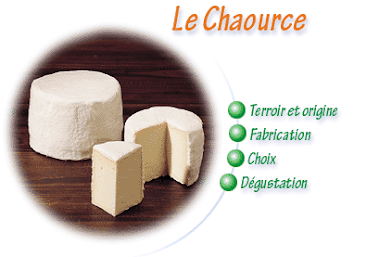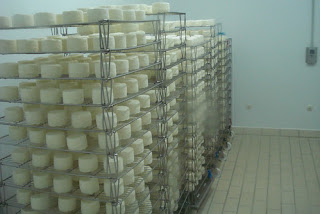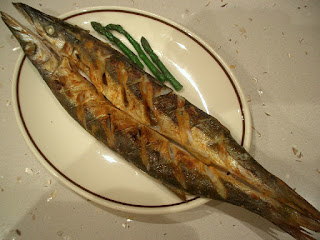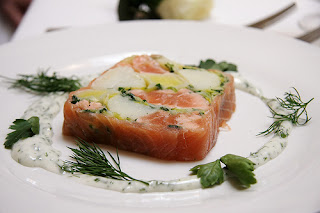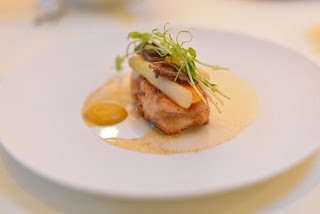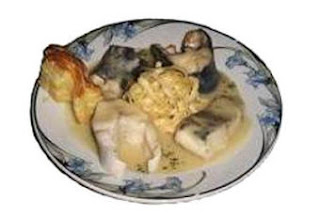from
Behind the French Menu
by
Bryan G. Newman
behindthefrenchmenu@gmail.com
Chaource AOP is a 24.5% fat, cow's milk cheese and, when ripe, is creamy, crumbly, and spreadable. It has a taste somewhat similar to a Brie, but a different texture, and that's what makes it unique. Chaource has an edible rind, and most farm-produced cheeses are made with unpasteurized milk, with dairies producing pasteurized versions. Similarities to Brie exist as they do in other cheeses like Coulommiers, but its Chaource's different texture that makes the final taste quite different.
New Chaource cheeses beginning their maturing process.
Aging Chaource
The cheese is matured for a minimum of two weeks before being sold. Then it will be allowed to age in the cool cellars of the better fromageries, cheese shops for another 30 to 45 days. When you buy this cheese, the center should be slightly soft and yield to the light pressure of a finger. In a fromagerie, you may request a cheese that will be ready for the same evening or a cheese that will be ready in ten days or two weeks. Chaource cheeses are available in small wheels weighing from 250 – 500 grams and from 8 - 10 cm high. For more about buying cheese in France and taking it home, click here.
The history of the Chaource cheese.
It is generally accepted that Chaource cheese was originated with the monks in the Abbey of Pontivy in Yonne, Burgundy, in the 15th century; this was long before the French revolutions and France's modern departments and administrative regions. The cheese was sold at the market in the village of Chaource, in the department of Aube; it was from this village the cheese took its name. Chaource is just 44 km (27 miles) from the Abbey of Pontivy. Today the production of Chaource is divided between the departments of Aube and Yonne.
The village of Chaource and getting there
The pretty village of Chaource, from whence the cheese took its name, has just over 1,000 inhabitants. Just over 50% of the cheese production comes from farms and dairies around the village. Paris to Chaource via a TGV fast takes about two hours, it's 209 km (130 miles) by road, and outside of the rush hours when you may lose time getting out of Paris, it's just over two hours by car.

The village of Chaource.
Photograph courtesy of
allispossible
www.flickr.com/photos/wheatfields/2860132005/
Chaource and its AOP
While the recipe for this cheese dates to the Middle Ages, until sixty years or so ago, it was just considered an excellent local cheese but rarely seen outside the area. Then came travelers, industry, and better roads and cheese gourmets. With the increase in demand, the farmers organized to ensure that the cheese was only made to agreed high standards. Finally, in 1986 the cheese Chaource received its AOC grading. There are over four hundred registered cheeses in France, but less than 50 have the right to an AOC, now an AOP, label, and Chaource is one of those. For more about AOC and AOP grades and labels, click here.
Chaource on French menus:
Andouillette de
Troyes AAAAA Sauce Chaource, Frites –
The Andouillette de Troyes AAAAA sausages with a
Chaource sauce and French fries. Andouillettes are one of France's favorite
sausages made with pork or veal tripe and intestines. The name Andouillettes
maybe sometimes be confused, by visitors, with another famous French sausage,
the Andouille. At first glance, there would seem to be many similarities as
both sausages are made with pork or veal tripe and intestines, but there the
difference ends. Andouillettes have a very healthy bite and for most visitors
are an acquired taste. The highly-rated Andouillette de Troyes AAAAA comes from
the town of Troyes in the same department as Chaource and just 30 km (19 miles)
away. The AAAAA after the name indicates the Association Amicale des Amateurs
d'Andouillette Authentiques, the Friendly Association of the Lovers of Authentic
Andouillette sausages, AAAAA for short; it is a manufacturers' association.

Baked
Macaroni, Chorizo, and Chaource Cheese
Photograph courtesy of Sainsbury's
Magazine
6 Escargots Sauce
Chaource – Six Petit-Gris snails served
with a Chaource cheese sauce. There are two snails raised for the table in
France; the larger and more expensive snail is the Burgundy snail, and if it
were being served, its name would be on the menu. The smaller snail is called
the Petit Gris, and they weigh approximately 10 grams each without their shell.
This still tasty, but smaller snail is the one on being served, and its size
indicates that this will be a French entrée (the first course). Each snail
weighs about 10grams, and so the serving will be approximately 60 grams (2 ounces).
Chaource et sa Petite Salade aux Noix –
Chaource cheese served with a small green and walnut salad.
Côte de Cochon
d'Antan Gratinée Au
Chaource - A pork chop from
free-range heirloom pigs served browned with a
covering of Chaource cheese. Cochon d'Antan translates as pigs from yesteryear
and will be a bread that is rarely seen today, and a question to the server may
bring some interesting history. When Cochon d'Antan is on the menu, you know
that you will be enjoying a rare treat.

Mini
Potato Gratins with Chaource Cheese
Photograph courtesy of Gourmandize
– UK, Ireland
Dos de Cabillaud Sauce
Chaource – Fresh cod served
with a sauce made with Chaource cheese. Cod is a large fish, often over 10
kilos ( 22 lbs), so you will be served a fillet. Fresh cod from the Atlantic
coast of France will rarely be seen; they have been overfished and are in
danger. The fresh cod on your table will mostly come from the North Atlantic
and flown in fresh or chilled. Fresh cod is one of the two most popular fish in
France with rehydrated salted cod, also very popular in many modern and
traditional dishes such as Brandade Nîmoise.
Salade de Chaource
Chaud au Miel –
A salad with warmed Chaource cheese served with honey.
Tournedos de Boeuf et Son Coulant de Chaource – A thick cut from a beef fillet served with warm, running Chaource cheese. Only two steaks of the size required for the original tournedos can be cut from the fillet, and initially, they were cooked together and separated just before serving. Today that will rarely be the case, but you should expect a 300 gram plus fillet steak. Tournedos as cuts trace their origins to the original Chateaubriand and Tournedos Rossini. For the post: Ordering a Steak in France, Cooked the Way you Like it click here.
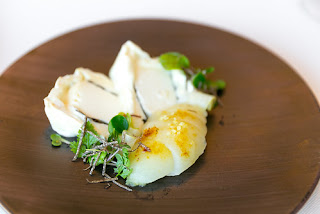
Truffled Chaource, Caramelized Pear with Lemon Confit
Photograph courtesy of City
Foodsters
www.flickr.com/photos/cityfoodsters/16513755169/
The wines that pair well with the Chaource
If you drive in the area and see vineyards, the grapes growing are most likely those used for Champagne. Chaource is in Champagne country, and the larger Champagne houses are in Reims only 155 km away ( 96 miles) and those of Épernay, 139 km (86 miles).

Chaource and Champagne
Photograph courtesy of SFGATE
The village of Chaource is also just 43 km (27 miles) from Chablis in Burgundy, where I first tasted the cheese then paired with a Chablis' white wine. The small town of Chablis and the area around it is also an excellent place to enjoy the cuisine of Burgundy with Chaource on the cheese plate at the end. Enjoy with Chablis or optionally pair Chaource with Burgundy's excellent sparkling Crémant de Bourgogne. Other famous cow's milk cheeses in Champagne country include the Langres AOP and the Cendré de Champagne; both of these cheeses are also produced just over Burgundy's border.
The Chaource cheese museum.
The village of Chaource has a cheese museum, their Musée du Fromage à Chaource, which is dedicated to this cheese alone; at the end of a visit, you are offered a tasting. The museum is open all year round, but from November to March by appointment, and in the time of the COVID19 pandemic, it's best to phone first at any time.

The cheese museum in Chaource
Photograph courtesy of
allispossible org uk
www.flickr.com/photos/wheatfields/2868060439/
The Chaource cheese fete.
On the second Sunday in October, the village has a Fête de Fromage, their cheese fete. If you are in the area visit, then you may enjoy demonstrations of cheese and butter making as well as tastings. N.B.: Always double-check the dates of fetes with the French Tourist Information Offices; dates do change.
The English language website for Chaource and the immediate area is:
http://www.tourisme-en-chaourcois.com/en/land-tasting/chaource-cheese
Visiting the area around Chaource.
The village of Chaource and the area around it is a beautiful place to visit. To the north, just 15 km (9 miles) from the village is the Parc Naturel Régional de la Forêt d'Orient, the natural regional park of the Forest d'Orient. Shades of the Knights Templar, who once owned the land upon which the park was created.
The park is extensive and covers over 750 sq km (290 sq miles); it includes lovely villages and lakes apart from areas covered with heavy forest. The park is a trendy vacation spot, and the lakes are centers for swimming and water sports. The lakes are also stocked with fish, making them very popular with amateur fishermen and women.
The park has a French-language website, but Bing and Google translate apps make it easily understood:
http://www.pnr-foret-orient.fr/fr/content/pnrfo
Visiting Chaource from Paris
If you stay in Paris and have access to a car, consider that a beautiful day trip can be a visit to Chaource. There are plenty of interesting and enjoyable stops along the way. For example, from Paris's drive to Melun, 45 km (28 miles) away, Melun is the home of one of the two AOP Brie cheeses. Then visit one of the two incredible Chateaus that are on your way. Choose the Château de Vaux le Vicomte, which is just 10 minutes away, 6 km (4 miles) from Melun, or choose the Château de Fontainebleau only 17 km (11 miles) away. After visiting either of the Chateaus for an enjoyable two-and-a-half to three-hour visit, have lunch in the area. It is just a 145 km (90 miles), a pleasant one and a half hour drive to Chaource. The return drive to Paris is a two-hour drive.
--------------------------------
Behind the French Menu
by
Bryan G. Newman
behindthefrenchmenu@gmail.com
Copyright 2010, 2015, 2020
--------------------------------
Are you searching for the meaning of words, names,
or phrases on French Menus?
Just add the word, words, or phrase you are searching for to the words "Behind the French Menu" and search with Google. Behind the French Menu's links include hundreds of words, names, and phrases that are seen on French menus. There are over 480 articles that include over 4,000 French dishes with English translations and explanations.
------------------

